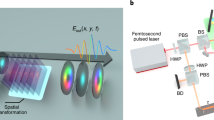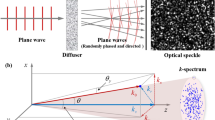Abstract
BECAUSE of the great distances involved, time measurements on astronomical events afford the best possibility for a high precision determination of the relative velocities of electromagnetic radiation at different wavelengths1. A discussion of flare stars, observed nearly simultaneously at optical and radio wavelengths, resulted in a relative uncertainty Δc/c of 4 × 10−7 over the wavelength range 0.54 microns–1.2 m. This gives a value of the product p=(c/Δc) (λ2/λ1) of about 5 × 1012, which is a factor of 10 greater than that which has been achieved in the laboratory2.
This is a preview of subscription content, access via your institution
Access options
Subscribe to this journal
Receive 51 print issues and online access
$199.00 per year
only $3.90 per issue
Buy this article
- Purchase on SpringerLink
- Instant access to full article PDF
Prices may be subject to local taxes which are calculated during checkout
Similar content being viewed by others
References
Lovell, B., Whipple, F. L., and Solomon, L. H., Nature, 202, 377 (1964).
Florman, E. F., J. Res. Nat. Bur. Stand., 54 (6), 335 (1955).
Cocke, W. J., Disney, M. J., and Taylor, D. J., Nature, 221, 525 (1969).
Nather, R. E., Warner, B., and MacFarlane, M., Nature, 221, 527 (1969).
Trimble, V., Astron. J., 73, 535 (1968).
Author information
Authors and Affiliations
Rights and permissions
About this article
Cite this article
WARNER, B., NATHER, R. Wavelength Independence of the Velocity of Light in Space. Nature 222, 157–158 (1969). https://doi.org/10.1038/222157b0
Received:
Issue date:
DOI: https://doi.org/10.1038/222157b0
This article is cited by
-
Testing fundamental physics with astrophysical transients
Frontiers of Physics (2021)
-
The speed of light and the new meter
Acta Physica Academiae Scientiarum Hungaricae (1974)
-
A Paradox in the Interaction of the Gravitational and Electromagnetic Fields ?
Nature (1970)
-
Further Observations of the Crab Nebula Optical Pulsar
Nature (1969)



